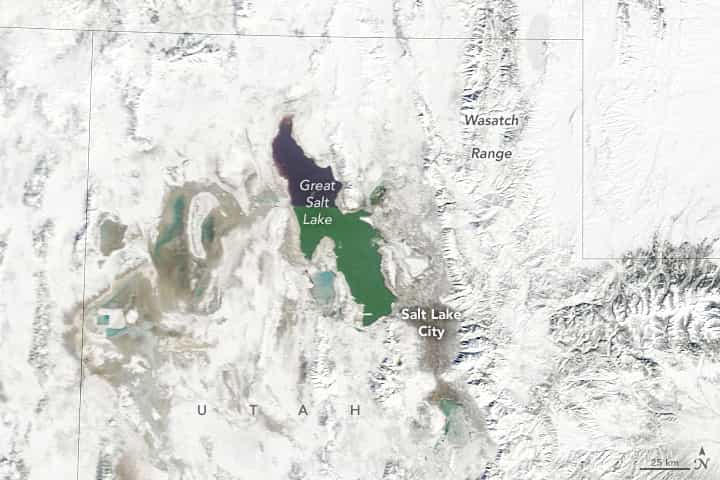
With a population of 1.2 million people, the Salt Lake City metropolitan area is relatively small. However, outbreaks of smog and particle pollution occasionally make its air among the most polluted in the United States.
That was the case between February 2-4, 2023, when data from the Environmental Protection Agency’s (EPA) Air Now system measured fine particulate matter (PM2.5) rising above 100 on the air quality index. EPA notes that this level is unhealthy for certain sensitive groups, including people with heart and lung disease, older adults, children, people with diabetes, and people of lower socioeconomic status.
- Related: Why Salt Lake City, UT Has Some of the World’s Worst Air Quality and What We Can Do to Fix It
The Salt Lake Valley’s pollution is especially noticeable in winter when the bowl-shaped valley is most prone to temperature inversions—a term meteorologists use to describe the phenomenon of warm, buoyant air moving over cooler, denser air near the surface. The warm air acts like a lid and traps pollutants close to the ground. In this region, the Wasatch Range, Oquirrh Mountains, and Traverse Mountains trap cold air in Salt Lake Valley and help shield the valley from stronger winds aloft that could otherwise clear out inversions.
“Temperature inversions and outbreaks of poor air quality are most common under high-pressure conditions in the winter,” explained University of Utah atmospheric scientist Sebastian Hoch. They typically develop on long, clear nights with calm winds when a layer of warm air aloft traps colder air in the basin below. “In the winter, the high reflectivity of snow and low sun angles limit daytime heating of the surface, making it easier for inversions to stay in place for days,” he added.
Snow cover was on full display when the Moderate Resolution Imaging Spectroradiometer(MODIS) on NASA’s Aqua satellite acquired this image on February 2, 2023. While the past few winters have delivered less snow than usual to northern Utah, data from the United States Department of Agriculture’s snow monitoring network (SNOTEL) and the NSIDC-NASA Snow Today tool showed more snow and a higher than average albedo around Great Salt Lake in February 2023.

“The ongoing drying of Great Salt Lake and reduction in the lake surface area has led to even more snow cover this winter than usual,” added Hoch. The photograph above, taken by Hoch, shows much of the Farmington Bay area, once part of the lake, now covered by snow on February 9, 2023.
Hoch and colleagues from the University of Utah analyzed the role that snow plays in exacerbating temperature inversions and poor air quality. They found that the chances that fine particulate matter would exceed national air pollution standards increased from about 5 percent when there was no snow on the ground to 22 percent when there was.
“Snow cover does not guarantee an inversion, but it increases the chances of one,” said Logan Mitchell, also an atmospheric scientist at the University of Utah. Mitchell has recently searched old newspapers and other historical sources to document the history of air pollution in the Salt Lake Valley.
A mix of sources contributes to the particulate matter that clouds skies during inversions, but the balance has changed over time. In the 1800s and mid-1900s, burning coal and wood to heat homes and power factories were key sources of particles. As cleaner sources of heat and power, such as natural gas, became available after World War II, cars and transportation have become the region’s top source of particulate pollution in recent decades.
“What surprised me is how long air pollution has been recognized as a problem in Utah,” Mitchell said. He pointed to historical references from the early 1800s of campfire smoke hanging in the sky for long periods, to newspaper editorials calling for improvements in 1881, to early legislative action to improve furnaces in 1891.
“There are reasons for optimism,” Mitchell added. “We know what causes air pollution, and we’ve seen significant declines in pollution in recent decades. We’re also starting to see the adoption of new technologies—like electric vehicles, electric heat pumps, and solar panels—that we’ll need to eventually make severe outbreaks of air pollution a thing of the past,” he said.
This post first appeared on NASA Earth Observatory. NASA Earth Observatory image by Lauren Dauphin, using MODIS data from NASA EOSDIS LANCE and GIBS/Worldview. Photograph by Sebastian Hoch (The University of Utah). Story by Adam Voiland.
Because a million eastern transplants move the salt lake basin, that’s one reason.